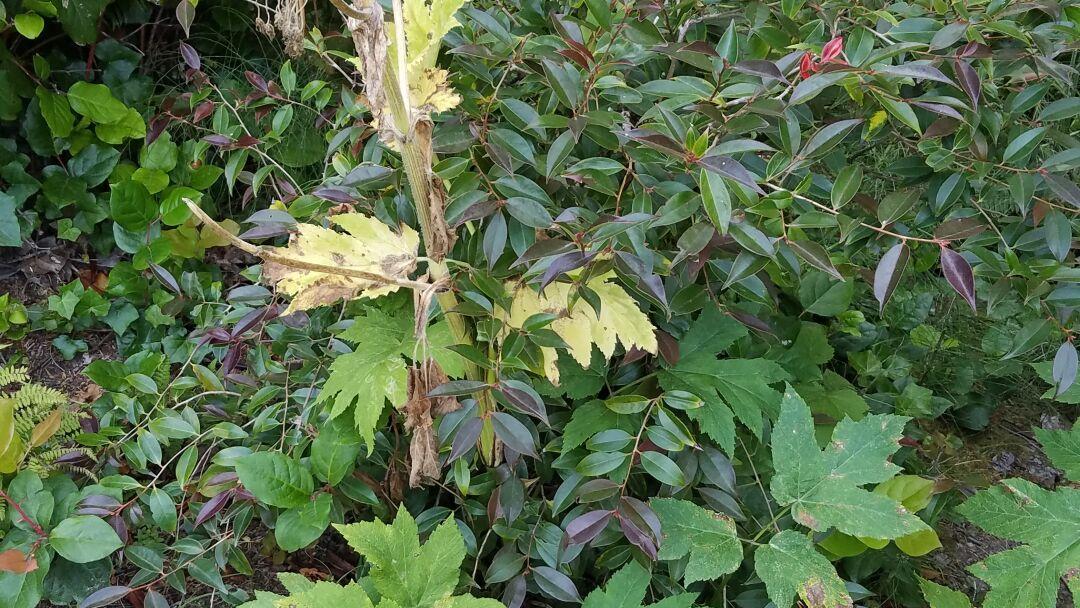
I think they smell like maple bars.
The seed heads of cow parsnip are mostly dry now, and the seeds are turning brown and papery. You may have noticed the stately plants (up to 7 feet tall) because of their large, flat heads (up to 8 inches wide) of small white flowers, and their broad, lobed leaves (up to 16 inches across). Native throughout North America, cow parsnip (Heracleum maximum, previously called Heracleum lanatum) favors damp places.
Cow parsnip’s green seeds have a faint, sweet fragrance, but the scent intensifies as the seeds mature and dry to brown.
Cow parsnips are members of the carrot family (Apiaceae, or Umbelliferae). Like other plant families, the identification is centered on the flowers: Members of this family have distinctive “umbels” in which many small flowers are clustered together on stalks, rather like bouquets on sticks, with the entire arrangement made up of many of the stalked clusters organized in a flat or domed head.
You’re likely familiar with Queen Anne’s lace (Daucus carota) — both the wild and the domesticated cultivars. The flat umbels of Queen Anne’s lace often have a characteristic burgundy-colored flower in the center of the cluster.
Scent is not uncommon in members of this plant family. And besides the obvious carrots, other members of Apiaceae have been domesticated, including parsnip, celery, dill, coriander/cilantro, fennel and parsley. Garden carrots and the other members of Apiaceae that we eat are particular species, subspecies, or varieties that have been domesticated.
Some other members of the carrot family are extremely poisonous. In fact, two of the most poisonous plants in North America are “carrots”: water hemlock (Cicuta douglasii) and poison hemlock (Conium maculatum).
The leaves and roots of the native water hemlock are more diagnostic of the species than the white flowers. Very rare among plants, and apparently unique among members of the carrot family, the secondary veins in the leaves point to the notches in the serrated leaves, rather than to the points. You might think of the veins pointing to graves, indicating the deadly poison. Another distinguishing characteristic of this species is the open chambers usually seen in the root, the most toxic part of the plant. A quarter-inch of water hemlock root can kill a person in a matter of minutes.
Another extremely poisonous local “carrot” is poison hemlock (Conium maculatum), a taller plant with lacy leaves and (usually) purple-spotted stems, and with a musty fragrance. Now very common in Oregon, poison hemlock was introduced to North America from Europe. (Poison hemlock was the source of the poison used to kill Socrates.)
(No, although they share a common name, these two water-loving “hemlocks” are not at all related to the hemlock tree.)
Giant hogweed (Heracleum mantegazzianum) is a more recent troublesome carrot family import to North America, including parts of Oregon. This invasive Eurasian native is giant, indeed: plants sometimes reach 18 feet tall and may have leaves nearly 5 feet across. The poisonous part of this plant is the sap that makes skin extremely sensitive to sun, causing rashes, burns and blisters.
While there are a couple of wild members of the Carrot Family that might be safely eaten by people, some of those species can be easily confused with the toxic ones. Although they are well worth appreciating by sight and smell, to be safe, never eat a “carrot” you didn’t obtain from a grocer or that was purposefully planted in a garden.
Sniff, but don’t taste.
(Marty Giles is owner/operator of Wavecrest Discoveries, long-running nature guiding service on the southern Oregon Coast.)
August 15, 2020 at 02:00AM
https://ift.tt/2PRYwbl
Nature Guide Journal: Not Bugs Bunny's carrots | Outdoors - Coos Bay World
https://ift.tt/2V2KNkZ
carrot
No comments:
Post a Comment